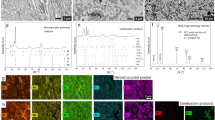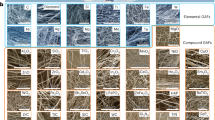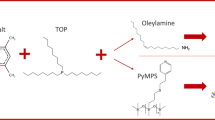Abstract
Although the theoretical tensile strength of alumina is ∼46 GPa (ref. 1), conventional powder processing rarely gives products better than 0.5 GPa because large defects, ∼50–100 µm in size, are invariably trapped during powder compaction2,3. Thin-film, fibrous, melt-processed and vapour-deposited ceramics can achieve higher strengths of several GPa (refs 4–6), but such processes are much more expensive than simple sintering of powder compacts. Here we show how colloidal control of powders to remove agglomerates can be used to give high-strength sintered ceramics: for example, a commercial alumina powder can be improved from 0.37 to 1.04 GPa in bend strength.
This is a preview of subscription content, access via your institution
Access options
Subscribe to this journal
Receive 51 print issues and online access
$199.00 per year
only $3.90 per issue
Buy this article
- Purchase on Springer Link
- Instant access to full article PDF
Prices may be subject to local taxes which are calculated during checkout
Similar content being viewed by others
References
1. Kelly, A. & Macmillan, N. H. Strong Solids, ch. 1 (Clarendon, Oxford, 1986). 2. Alford, N. McN., Birchall, J. D. & Kendall, K. Mater. Sci. Technol. 2, 329-336 (1986). 3. Lange, F. F. J. Am. ceram. Soc. 66, 396-398 (1983). 4. Mallinder, F. P. & Proctor, B. A. Phil Mag. 13, 197-208 (1966). 5. Soltis, P. J. Bull Am. phys. Soc. 10, 163 (1965). 6. Birchall, J. D., Bradbury, J. A. A. & Dinwoodie, J. in Handbook of Composites Vol. 1 (eds Watt, W. & Perov, B. V.) 115-154 (Elsevier, Amsterdam, 1985). 7. Abe, H. Bull. Am. ceram. Soc. 64, 1594-1596 (1985). 8. Griffith, A. A. Phil Trans. R. Soc. A221, 163-198 (1920). 9. Koiter, W. T. Proc. R. Neth. Acad. Sci. B59, 354-374 (1956). 10. Brennan, J. J. & Prewo, K. M. / Mater. Sci. 17, 2371-2383 (1982). 11. Sambell, R. A. J., Bowen, D. H. & Phillips, D. C. / Mater. Sci. 7, 663-675 (1972). 12. Garvie, R. S., Hannink, R. J. H. & Pascoe, R. T. Nature 258, 703-705 (1975). 13. Claussen, N. & Ruble, M. in Advances in Ceramics Vol. 4 (eds Heuer, A. H. & Hobbs, L. W.) 137-163 (American Ceramic Society, Columbus, 1981). 14. Aksay, I. A., Lange, F. F. & Davis, B. I. / Am. ceram. Soc. 66, C190-C192 (1983). 15. Lange, F. F., Davis, B. I. & Aksay, I. A. J. Am. ceram. Soc. 66, 407-408 (1983). 16. Lange, F. F. J. Am. ceram. Soc. 67, 83-89 (1984). 17. Lange, F. F., Davis, B. I. & Wright, E. J. Am. ceram. Soc. 69, 66-69 (1986). 18. Davidge, R. W. in Fracture Mechanics of Ceramics Vol. 2 (eds Bradt, R. C., Hasselman, D. P. H. & Lange, F. F.) 447-468 (Plenum, New York, 1973). 19. Alford, N. McN., Kendall, K., Clegg, W. J. & Birchall, J. D. J. Am. ceram. Soc. (submitted). 20. Ritter, J. E. & Davidge, R. W. J. Am. ceram. Soc. 67, 432-437 (1984). 21. Weibull, W. /. appl. Mech. 18, 293-297 (1951). 22. Kendall, K., Alford, N. McN. & Birchall, J. D. Spec. Ceram. 8, 255-265 (1986). 23. Kendall, K. in Tribology of Powders (eds Briscoe, B. J. & Adams, M. J.) (Hilger, Bristol) in the press). 24. Eur. Pat. Publ. no. 0183453. 25. Br. Pat. Appl. no. 8709598.
Author information
Authors and Affiliations
Rights and permissions
About this article
Cite this article
Alford, N., Birchall, J. & Kendall, K. High-strength ceramics through colloidal control to remove defects. Nature 330, 51–53 (1987). https://doi.org/10.1038/330051a0
Received:
Accepted:
Issue Date:
DOI: https://doi.org/10.1038/330051a0
This article is cited by
-
Role of Surface-Chemistry in Colloidal Processing of Ceramics: A Review
Transactions of the Indian Institute of Metals (2023)
-
A comparative study of nano-fillers to improve toughness and modulus of polymer-derived ceramics
Scientific Reports (2021)
-
New Lightweight Kiln Furniture Made by Combination of Ceramic Green Tapes and Extrudates
Interceram - International Ceramic Review (2015)
-
1-3 Piezocomposites realised from small feature size, high aspect ratio, hot embossed moulds. Part II: piezocomposite fabrication
Microsystem Technologies (2010)
-
Inhomogeneity of powder packing in compacts and strength of the ceramics obtained
Refractories and Industrial Ceramics (1997)
Comments
By submitting a comment you agree to abide by our Terms and Community Guidelines. If you find something abusive or that does not comply with our terms or guidelines please flag it as inappropriate.



